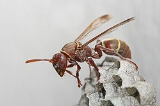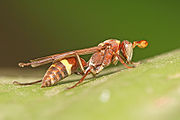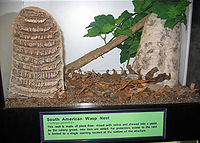
Polistinae
Encyclopedia
The Polistinae are eusocial wasp
s closely related to the more familiar yellowjacket
s, but placed in their own subfamily, containing four tribes; with some 1100 species total, it is the second most diverse subfamily within Vespidae, and while most species are tropical or subtropical, they include some of the most frequently-encountered large wasps in temperate regions. They are also known as paper wasp
s, which is a misleading term since other wasps (including yellowjackets) also build nests out of paper, and because some Epiponine wasps (e.g., Polybia emaciata) build theirs out of mud http://www.insectscience.org/2.3/O'Donnell_and_Jeanne,_JIS_2.3_2002.pdf, nonetheless, the name paper wasp seems to apply mostly, but not exclusively, to the Polistinae, especially the Polistini. The brood cells are arranged in a hexagonal array, similar to the comb structure in a honey bee
nest. At least one Epiponine species (Brachygastra mellifica
) stores honey
in the comb, one of the only insects other than bees to store honey.
 Characteristics of Polistinae are:
Characteristics of Polistinae are:
 Polistine wasps found colonies in one of two ways. In some species, nests are founded by a small number of reproductive females, possibly a single one. One of the foundresses eventually acquires dominance over the other and is the sole reproducer. The nest is open (not enclosed by an envelope) and contains a single comb.
Polistine wasps found colonies in one of two ways. In some species, nests are founded by a small number of reproductive females, possibly a single one. One of the foundresses eventually acquires dominance over the other and is the sole reproducer. The nest is open (not enclosed by an envelope) and contains a single comb.
In the other group, called swarm-founding, the nest is founded by a large number of workers and a few queens. It is usually protected by an envelope, like a vespine nest.
 Tribe Polistini
Tribe Polistini
Tribe Mischocyttarini
Tribe Epiponini
Tribe Ropalidiini
Wasp
The term wasp is typically defined as any insect of the order Hymenoptera and suborder Apocrita that is neither a bee nor an ant. Almost every pest insect species has at least one wasp species that preys upon it or parasitizes it, making wasps critically important in natural control of their...
s closely related to the more familiar yellowjacket
Yellowjacket
Yellowjacket is the common name in North America for predatory wasps of the genera Vespula and Dolichovespula. Members of these genera are known simply as "wasps" in other English-speaking countries...
s, but placed in their own subfamily, containing four tribes; with some 1100 species total, it is the second most diverse subfamily within Vespidae, and while most species are tropical or subtropical, they include some of the most frequently-encountered large wasps in temperate regions. They are also known as paper wasp
Paper wasp
Paper wasps are -long wasps that gather fibers from dead wood and plant stems, which they mix with saliva, and use to construct water-resistant nests made of gray or brown papery material...
s, which is a misleading term since other wasps (including yellowjackets) also build nests out of paper, and because some Epiponine wasps (e.g., Polybia emaciata) build theirs out of mud http://www.insectscience.org/2.3/O'Donnell_and_Jeanne,_JIS_2.3_2002.pdf, nonetheless, the name paper wasp seems to apply mostly, but not exclusively, to the Polistinae, especially the Polistini. The brood cells are arranged in a hexagonal array, similar to the comb structure in a honey bee
Honey bee
Honey bees are a subset of bees in the genus Apis, primarily distinguished by the production and storage of honey and the construction of perennial, colonial nests out of wax. Honey bees are the only extant members of the tribe Apini, all in the genus Apis...
nest. At least one Epiponine species (Brachygastra mellifica
Brachygastra mellifica
Brachygastra mellifica, commonly known as the Mexican Honey Wasp, is a small Neotropical paper wasp that is distributed from southern Texas and extreme southeastern Arizona in the United States south through Mexico and Central America...
) stores honey
Honey
Honey is a sweet food made by bees using nectar from flowers. The variety produced by honey bees is the one most commonly referred to and is the type of honey collected by beekeepers and consumed by humans...
in the comb, one of the only insects other than bees to store honey.

- queens (reproductive females) morphologically similar to workers, though sometimes slightly larger or differently colored
- the abdomen is spindle-shaped, often petiolate
- the antennae of males are curled
- the nest is sometimes open (the nests of vespines are typically enclosed in several layers of paper)
Colony life cycle

In the other group, called swarm-founding, the nest is founded by a large number of workers and a few queens. It is usually protected by an envelope, like a vespine nest.
Selected species of Polistinae

- Genus PolistesPolistesWasps of the cosmopolitan genus Polistes are the most familiar of the polistine wasps, and are the most common type of paper wasp. It is also the single largest genus within the family Vespidae, with over 300 recognized species and subspecies...
- P. annularisPolistes annularisPolistes annularis is a species of paper wasp which lives in North America.-Description:Unusually for a North American Polistes, P. annularis shows little sexual dimorphism in coloration. It resembles Polistes metricus, which differs from P. annularis in a number of ways, including the coloration...
- P. bellicosus
- P. biglumis
- P. bischoffi
- P. carolinus - Red paper wasp
- P. chinensisPolistes chinensisPolistes chinensis is a polistine vespid in the cosmopolitan genus Polistes, and is commonly known as the Asian, Chinese or Japanese paper wasp. It is found in East Asia . The subspecies Polistes chinensis antennalis is a common non-native insect of New Zealand, arriving in 1979...
- Chinese paper wasp - P. dominulaPolistes dominulaPolistes dominula , sometimes referred to as the European paper wasp, is one of the more common and well-known species of social wasps in Europe...
- European paper wasp - P. fuscatus - Northern paper wasp
- P. humilis - Common paper wasp
- P. tepidus
- P. annularis
Tribe Mischocyttarini
- Genus MischocyttarusMischocyttarusMischocyttarus is a very large, primarily Neotropical genus of social wasps with a few species found also in the Nearctic region. It is the only member of its own tribe, the Mischocyttarini....
- M. collarellus
- M. flavitarsis
- M. labiatus
Tribe Epiponini
Epiponini
The Epiponini are a large and diverse tribe of social wasps mostly inhabiting the Neotropical region, with some species found also in the Nearctic region....
- Genus BrachygastraBrachygastraBrachygastra is a small genus of Neotropical paper wasps, well-known as being one of the very few types of insects other than bees that produce and store honey.- Selected species :*Brachygastra lecheguana*Brachygastra mellifica...
- B. mellificaBrachygastra mellificaBrachygastra mellifica, commonly known as the Mexican Honey Wasp, is a small Neotropical paper wasp that is distributed from southern Texas and extreme southeastern Arizona in the United States south through Mexico and Central America...
- B. mellifica
- Genus PolybiaPolybiaPolybia is a genus of eusocial wasps.-Species:* Polybia aequatorialis Zavattari, 1906* Polybia affinis Buysson, 1908* Polybia anglica Cockerell, 1921* Polybia barbouri Bequard, 1943* Polybia batesi Richards, 1978...
- P. emaciata
- P. occidentalis
- P. scutellaris
Tribe Ropalidiini
Ropalidiini
Ropalidiini is a tribe of social wasps inhabiting the Afrotropical, Indomalayan and Australasian biogeographical regions....
- Genus RopalidiaRopalidiaRopalidia is a large genus of eusocial paper wasps in the tribe distributed throughout the Afrotropical, Indomalayan and Australasian biogeographical regions...
- R. marginataRopalidia marginataRopalidia marginata is an Old World species of paper wasp found in Pakistan, peninsular India, Sri Lanka, South-east Asia and Australia. It was originally described by Fabricius in 1793 under the name Vespa ferruginea, but that name was preoccupied, so the oldest available name for the species is...
- R. revolutionalis
- R. marginata

